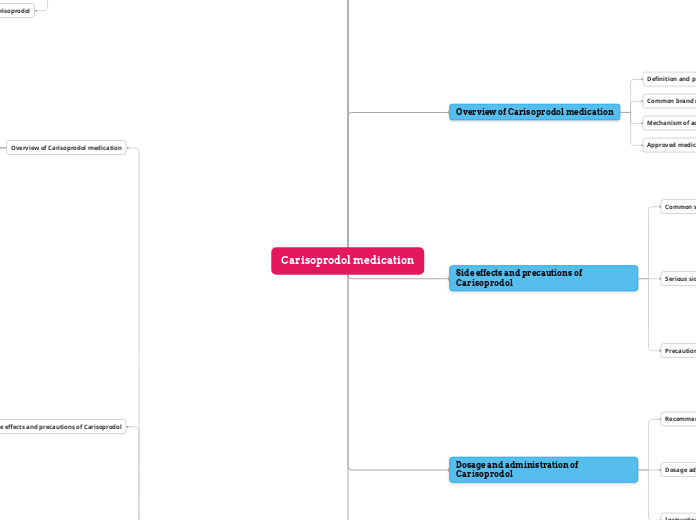Carisoprodol medication
Main topic
Overview of Carisoprodol medication
Definition and purpose of Carisoprodol
Common brand names and forms of Carisoprodol
Mechanism of action and how it works in the body
Approved medical uses for Carisoprodol
Side effects and precautions of Carisoprodol
Common side effects
Drowsiness and dizziness
Headache and blurred vision
Upset stomach and vomiting
Serious side effects
Severe allergic reactions
Difficulty breathing and chest pain
Rapid heartbeat and confusion
Precautions and warnings for Carisoprodol use
Contraindications for certain medical conditions
Potential interactions with other medications
Safety considerations for pregnant or breastfeeding women
Dosage and administration of Carisoprodol
Recommended dosage for adults
Initial dose and frequency of use
Maximum daily dosage
Dosage adjustments for specific populations
Elderly patients
Patients with liver or kidney impairment
Instructions for administration
Taking Carisoprodol with or without food
Swallowing tablets whole with water
Potential risks and abuse of Carisoprodol
Risk of addiction and dependence
Carisoprodol as a controlled substance
Signs and symptoms of addiction
Misuse and recreational use of Carisoprodol
Combination with other substances for enhanced effects
Legal and ethical concerns surrounding misuse
Withdrawal symptoms and discontinuation of Carisoprodol
Symptoms of Carisoprodol withdrawal
Anxiety and irritability
Insomnia and restlessness
Muscle aches and tremors
Tapering off and discontinuing Carisoprodol
Gradual reduction of dosage
Medical supervision and support during withdrawal process
Detailed breakdown
Overview of Carisoprodol medication
Definition and purpose of Carisoprodol
Carisoprodol is a muscle relaxant that works by blocking pain sensations between the nerves and the brain
Common brand names and forms of Carisoprodol
Common brand names include Soma and Vanadom
Available in tablet form
Mechanism of action and how it works in the body
Carisoprodol acts on the central nervous system to produce muscle relaxation
It enhances the inhibitory effects of GABA receptors in the brain
Approved medical uses for Carisoprodol
Carisoprodol is primarily used as a short-term treatment for acute musculoskeletal pain
Side effects and precautions of Carisoprodol
Common side effects
Drowsiness and dizziness
Patients may experience drowsiness or feel lightheaded
Headache and blurred vision
Some individuals may develop headaches or experience blurred vision
Upset stomach and vomiting
Nausea and vomiting are potential side effects of Carisoprodol
Serious side effects
Severe allergic reactions
Rare cases of severe allergic reactions
such as rash or swelling
may occur
Difficulty breathing and chest pain
Any difficulty breathing or chest pain should be reported to a healthcare provider immediately
Rapid heartbeat and confusion
Rapid heartbeat or confusion may indicate a serious adverse reaction to the medication
Precautions and warnings for Carisoprodol use
Contraindications for certain medical conditions
Carisoprodol should be avoided in individuals with a history of porphyria or hypersensitivity to the drug
Potential interactions with other medications
Carisoprodol may interact with other medications
such as opioids or sedatives
leading to increased sedation
Safety considerations for pregnant or breastfeeding women
Carisoprodol is not recommended for use during pregnancy or while breastfeeding due to potential risks to the fetus or infant
Dosage and administration of Carisoprodol
Recommended dosage for adults
Initial dose and frequency of use
The typical starting dose is 250 to 350 mg taken three times a day
Maximum daily dosage
The maximum recommended daily dosage is 1400 mg
Dosage adjustments for specific populations
Elderly patients
Lower doses may be necessary for elderly patients due to the increased risk of side effects
Patients with liver or kidney impairment
Patients with liver or kidney impairment may require dosage adjustments to prevent drug accumulation and potential toxicity
Instructions for administration
Taking Carisoprodol with or without food
Carisoprodol may be taken with or without food
but taking it with food can help reduce stomach upset
Swallowing tablets whole with water
Tablets should be swallowed whole with a full glass of water and should not be crushed or chewed
Potential risks and abuse of Carisoprodol
Risk of addiction and dependence
Carisoprodol as a controlled substance
Carisoprodol is classified as a Schedule IV controlled substance due to its potential for abuse and dependence
Signs and symptoms of addiction
Signs of Carisoprodol addiction may include cravings
loss of control
and neglect of responsibilities
Misuse and recreational use of Carisoprodol
Combination with other substances for enhanced effects
Carisoprodol is often misused in combination with other substances
such as opioids or benzodiazepines
to enhance the sedative effects
Legal and ethical concerns surrounding misuse
Misuse of Carisoprodol is illegal and poses significant risks to individuals
including overdose and respiratory depression
Withdrawal symptoms and discontinuation of Carisoprodol
Symptoms of Carisoprodol withdrawal
Anxiety and irritability
Withdrawal from Carisoprodol may result in feelings of anxiety and irritability
Insomnia and restlessness
Individuals may experience difficulty sleeping and restlessness during withdrawal
Muscle aches and tremors
Muscle aches and tremors are common withdrawal symptoms associated with Carisoprodol
Tapering off and discontinuing Carisoprodol
Gradual reduction of dosage
To minimize withdrawal symptoms
Carisoprodol should be gradually tapered off under medical supervision
Medical supervision and support during withdrawal process
Medical supervision and support can provide guidance and assistance throughout the discontinuation process to ensure safety and comfort
